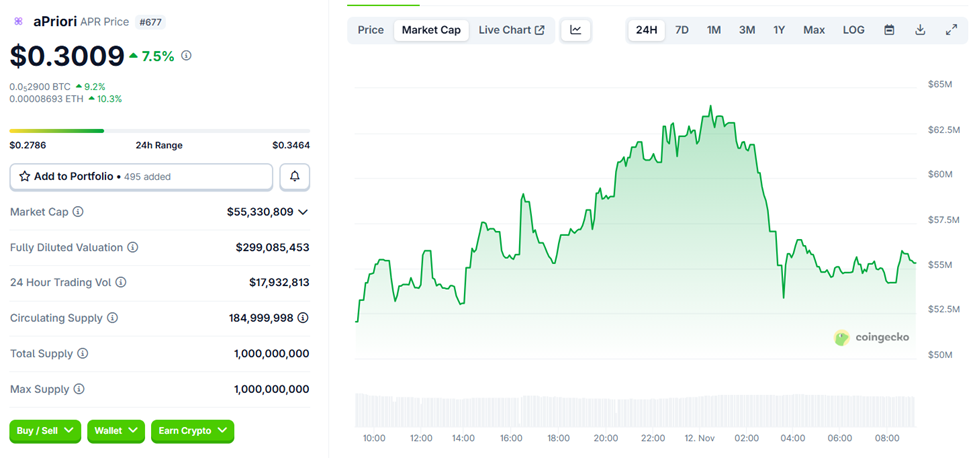Did One Whale Steal aPriori’s Airdrop? 14,000 Wallets Raise Big Questions
A single entity claimed 60% of aPriori's APR airdrop, sparking debate on crypto fairness.
Liquid staking project aPriori, preparing to join the Monad, has raised $30 million from Tier-1 VCs. However, it now faces accusations that one entity used 14,000 connected addresses to claim more than 60% of its airdrop.
The revelations have rattled markets and raised fresh questions about airdrop design and on-chain verification.
On-Chain Picture Behind aPriori: What Happened?
aPriori (APR) announced the claim portal on October 23, with its public window and split-claim mechanic (early vs. wait) appearing to have been gamed by the clustered wallets.
Airdrop claim is live.Check eligibility and claim at .You have 21 days to choose:• Claim Early: smaller portion now• Wait for Monad Mainnet: unlock majority laterChoose carefully, your selection is final.
— aPriori ⌘ (@aPriori) October 23, 2025
Indeed, Bubblemaps, a visual analytics platform for on-chain trading and investigations, flagged an unusually tight cluster of new wallets that claimed aPriori’s October 23 airdrop.
According to Bubblemaps, the project raised $30 million from tier-1 VCs. However, 60% of its airdrop was claimed by one entity via 14,000 connected or clustered addresses.
Reportedly, the cluster’s behavior involved wallets that were freshly funded via the Binance exchange, with approximately 0.001 BNB, in short windows. They then routed APR to new addresses, suggesting an orchestrated claim-and-redistribute operation rather than an organic, distributed claiming process.
3/ However, 14,000 connected addresses claimed 60%+ of the $APR airdropThese addresses were:> Freshly funded via Binance> Received 0.001 BNB each in tight time windows> Sent $APR to fresh addresses, forming a second layer in the cluster
— Bubblemaps (@bubblemaps) November 11, 2025
Project Messaging and Timing
The fallout was immediate, with a sharp sell-off following the cluster activity. Likewise, there was a dramatic drop in the APR market cap soon after launch.
 aPriori (APR) Price and Market Cap Performance. Source:
CoinGecko
aPriori (APR) Price and Market Cap Performance. Source:
CoinGecko
Concentrated airdrop claims, especially when claimers flip tokens quickly, can wipe out community trust and trigger steep repricing before a project reaches mainnet.
Why It Matters — Incentives, Verification, And Reputation
Crypto airdrops are meant to decentralize token ownership and bootstrap network effects. When a single actor captures the majority of distributed tokens, three problems arise:
- Incentive misalignment, where the token supply is effectively centralized
- Economic risk, where large concentrated holders can dump and destabilize the price, and
- Reputational damage, where partnerships and future fundraisers can be imperiled.
For aPriori, touted as “one of the biggest projects coming to Monad,” reputational risk now threatens its own rollout as well as associated ecosystem events.
Meanwhile, this scandal comes at a moment when Lighter is being celebrated as a model for institutional-grade DeFi growth. The Layer-2 DEX recently raised $68 million and surpassed $73 billion in weekly perpetual trading volume, emphasizing speed, scalability, and transparent on-chain execution.
Lighter is pursuing a zero-knowledge orderbook model to attract serious liquidity providers. By contrast, aPriori’s airdrop issues remind investors how easily tokenomics can be undermined by automation and poor verification.
Similarly, aPriori’s Sybil-attack-like airdrop highlights the fragility of token distribution mechanics still common in DeFi.
Bubblemaps says it reached out to the aPriori team but received no response; the project has not publicly disputed the cluster analysis.
As investigations continue and on-chain forensics deepen, aPriori’s path to the Monad mainnet and any associated MON sales will be closely monitored and evaluated based on on-chain evidence and, potentially, developer communication.
Disclaimer: The content of this article solely reflects the author's opinion and does not represent the platform in any capacity. This article is not intended to serve as a reference for making investment decisions.
You may also like
UAE’s Digital Dirham: Shaping a Diverse Future for International Finance
- UAE completes first government transaction using Digital Dirham CBDC via mBridge platform, settling in under two minutes. - Pilot by UAE Ministry of Finance and Dubai Department of Finance validates cross-border and domestic payment capabilities without intermediaries. - Officials highlight CBDC's role in enhancing financial transparency, reducing settlement times, and advancing UAE's fintech leadership goals. - Global CBDC adoption grows with 137 countries exploring digital currencies, as UAE plans phas

Yen-backed Stablecoin Initiative May Challenge the Dollar’s Leading Role in Digital Finance
- JPYC, Japan's yen-pegged stablecoin issuer, plans to allocate 80% of 10-trillion-yen token proceeds to JGBs, aiming to fill gaps left by BOJ's stimulus tapering. - The strategy could reshape Japan's bond market as BOJ reduces its 50% JGB ownership stake, with JPYC CEO predicting global adoption of stablecoin-driven government bond demand. - Japan's FSA supports innovation through sandbox programs, including a pilot with major banks , while regulators warn stablecoins might divert funds from traditional b

COAI's Unexpected Price Decline in Early November 2025: An Indicator of Fluctuations in the AI Industry
- Canaan Inc. (COAI) saw a sharp stock price drop in early November 2025 amid AI/crypto sector volatility driven by regulatory uncertainty and strategic shorting. - C3.ai's 54% YTD decline and exploration of a potential sale highlighted the sector's shift from speculative hype to earnings-focused scrutiny. - Gemini's poor Q3 earnings and Nano Labs' bond redemption signaled broader pessimism, amplifying COAI's 88% YTD valuation decline. - Analysts project 20% downside for AI sector valuations, emphasizing p

Dogecoin News Update: Poain Launches 'Stablecoin 2.0' Featuring AI-Powered Returns and Green Energy Infrastructure
- Poain BlockEnergy expanded its AI-powered staking platform to include USDT , offering stablecoin yield generation via smart contracts and a presale for its PEB token. - The platform uses renewable energy-powered AI algorithms to optimize staking returns, providing a low-risk alternative to traditional trading with flexible 2-10 day plans. - Users can withdraw or reinvest profits in multiple assets, while PEB’s presale roadmap projects a 300x price increase from $0.007 to $2.50, pending adoption and regul

